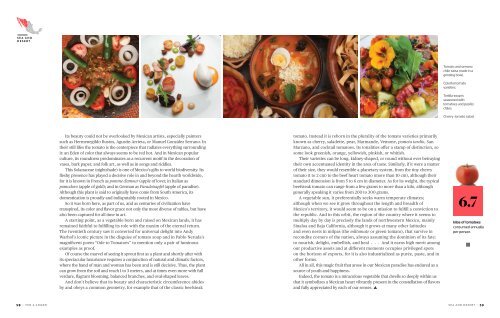ven-a-comer-e-book-en_1
ven-a-comer-e-book-en_1
ven-a-comer-e-book-en_1
Create successful ePaper yourself
Turn your PDF publications into a flip-book with our unique Google optimized e-Paper software.
sea and<br />
desert<br />
Tomato and serrano<br />
chile salsa made in a<br />
grinding bowl.<br />
Colorful tomato<br />
varieties.<br />
Tortilla soup is<br />
seasoned with<br />
tomatoes and pasilla<br />
chiles.<br />
Cherry-tomato salad.<br />
Its beauty could not be overlooked by Mexican artists, especially painters<br />
such as Herm<strong>en</strong>egildo Bustos, Agustín Arrieta, or Manuel González Serrano. In<br />
their still lifes the tomato is the c<strong>en</strong>terpiece that radiates everything surrounding<br />
it: an Ed<strong>en</strong> of color that always seems to be red hot. And in Mexican popular<br />
culture, its roundness predominates as a recurr<strong>en</strong>t motif in the decoration of<br />
vases, bark paper, and folk art, as well as in songs and riddles.<br />
This Solanaceae (nightshade) is one of Mexico’s gifts to world biodiversity. Its<br />
fleshy pres<strong>en</strong>ce has played a decisive role in and beyond the hearth worldwide,<br />
for it is known in Fr<strong>en</strong>ch as pomme d’amour (apple of love); in Italian as<br />
pomodoro (apple of gold); and in German as Paradeisapfel (apple of paradise).<br />
Although this plant is said to originally have come from South America, its<br />
domestication is proudly and indisputably rooted in Mexico.<br />
So it was born here, as part of us, and as c<strong>en</strong>turies of civilization have<br />
transpired, its color and flavor grace not only the most diverse of tables, but have<br />
also be<strong>en</strong> captured for all time in art.<br />
A starting point, as a vegetable born and raised on Mexican lands, it has<br />
remained faithful to fulfilling its role with the maxim of the eternal return.<br />
The tw<strong>en</strong>tieth c<strong>en</strong>tury saw it converted for universal delight into Andy<br />
Warhol’s iconic picture in the disguise of tomato soup and in Pablo Neruda’s<br />
magnific<strong>en</strong>t poem “Ode to Tomatoes” to m<strong>en</strong>tion only a pair of luminous<br />
examples as proof.<br />
Of course the marvel of seeing it sprout first as a plant and shortly after with<br />
its spectacular luxuriance requires a conjunction of natural and climatic factors,<br />
where the hand of man and woman has be<strong>en</strong> and is still decisive. Thus, the plant<br />
can grow from the soil and reach 1 to 3 meters, and at times e<strong>v<strong>en</strong></strong> more with full<br />
verdure, flagrant blooming, balanced branches, and oval-shaped leaves.<br />
And don’t believe that its beauty and characteristic circumfer<strong>en</strong>ce abides<br />
by and obeys a common geometry, for example that of the classic beefsteak<br />
tomato. Instead it is reborn in the plurality of the tomato varieties primarily<br />
known as cherry, saladette, pear, Marmande, Vemone, pometa tardío, San<br />
Marzano, and cocktail tomatoes. Its tonalities offer a stamp of distinction, so<br />
some look gre<strong>en</strong>ish, orange, yellowish, pinkish, or whitish.<br />
Their varieties can be long, kidney-shaped, or round without ever betraying<br />
their own acc<strong>en</strong>tuated id<strong>en</strong>tity in the area of taste. Similarly, if it were a matter<br />
of their size, they would resemble a planetary system, from the tiny cherry<br />
tomato (1 to 2 cm) to the beef heart tomato (more than 10 cm), although their<br />
standard dim<strong>en</strong>sion is from 5 to 6 cm in diameter. As for its weight, the typical<br />
beefsteak tomato can range from a few grams to more than a kilo, although<br />
g<strong>en</strong>erally speaking it varies from 200 to 300 grams.<br />
A vegetable sun, it prefer<strong>en</strong>tially seeks warm temperate climates;<br />
although wh<strong>en</strong> we see it grow throughout the l<strong>en</strong>gth and breadth of<br />
Mexico’s territory, it would seem to be on a mission to fulfill a conviction to<br />
the republic. And in this orbit, the region of the country where it seems to<br />
multiply day by day is precisely the lands of northwestern Mexico, mainly<br />
Sinaloa and Baja California, although it grows at many other latitudes<br />
and e<strong>v<strong>en</strong></strong> nests in milpas (the miltomate or gre<strong>en</strong> tomato), that survive in<br />
recondite corners of the nation, always assuming the dominion of its fate:<br />
to nourish, delight, embellish, and heal . . . And it earns high merit among<br />
our productive assets and at differ<strong>en</strong>t mom<strong>en</strong>ts occupies privileged spots<br />
on the horizon of exports, for it is also industrialized as purée, paste, and in<br />
other forms.<br />
All in all, this magic fruit that arose in our Mexican paradise has <strong>en</strong>dured as a<br />
source of youth and happiness.<br />
Indeed, the tomato is a miraculous vegetable that dwells so deeply within us<br />
that it symbolizes a Mexican heart vibrantly pres<strong>en</strong>t in the constellation of flavors<br />
and fully appreciated by each of our s<strong>en</strong>ses. ▲<br />
6.7<br />
kilos of tomatoes<br />
consumed annually<br />
per person.<br />
n<br />
58 — V<strong>en</strong> a Comer sea and deserT — 59


